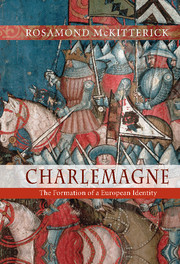Book contents
- Frontmatter
- Dedication
- Contents
- List of maps
- List of tables
- Preface
- List of abbreviations
- 1 Representations of Charlemagne
- 2 Pippinids, Arnulfings and Agilolfings: the creation of a dynasty
- 3 The royal court
- 4 The king and the kingdom: communications and identities
- 5 Correctio, knowledge and power
- Bibliography
- Index of manuscripts
- General index
3 - The royal court
Published online by Cambridge University Press: 05 August 2015
- Frontmatter
- Dedication
- Contents
- List of maps
- List of tables
- Preface
- List of abbreviations
- 1 Representations of Charlemagne
- 2 Pippinids, Arnulfings and Agilolfings: the creation of a dynasty
- 3 The royal court
- 4 The king and the kingdom: communications and identities
- 5 Correctio, knowledge and power
- Bibliography
- Index of manuscripts
- General index
Summary
INTRODUCTION
Political power and its location had become more decentralized and less institutionalized in the post-Roman world. The Carolingian construction of a network of regional centres of power, a ‘topography of power’, appears to offer an instance of such decentralization within the much-expanded regnum francorum, with a ‘great chain of palaces’ whose symbolic role was enhanced from time to time by the king's presence or by the conduct of the king's business.
A distinctive feature of Carolingian rule was the plurality of political and administrative centres and the maintenance of communications between these centres and their surrounding regions. How this worked in relation to a ‘royal court’ or the royal household needs a fresh examination, not least to see how Charlemagne developed a royal court, or a number of royal courts, from the base provided by his father Pippin. Charlemagne's court is too often seen as a static and unchanging institution, and described in terms of conditions during the last few years of his reign and the early period of the reign of Louis the Pious. Both the evidence for the ‘court’ and the role of the many royal palaces within the empire, therefore, need to be reassessed in relation to the apparent agreement among modern scholars concerning the dominance of the palace at Aachen, and their confidence in the character of the court based there. Neither the role of Aachen nor the court is unproblematic. The complicating factors are the degree to which either the king or the court was itinerant and how integral itinerancy was to the system of Carolingian government as it was developed under Charlemagne. The current perception of the court is of a single itinerant institution which eventually ‘settled at Aachen’ around 794. Thus the structure of the royal household, the practical manifestations of itinerancy, the stages at which the household and its satellites may or may not have ‘settled’, and the light these throw on how centralized or dispersed Charlemagne's rule was, are all interconnected issues. I look first, therefore, at the evidence for the royal household and its structure, and the appropriateness of its designation as a court.
- Type
- Chapter
- Information
- CharlemagneThe Formation of a European Identity, pp. 137 - 213Publisher: Cambridge University PressPrint publication year: 2008
- 1
- Cited by



